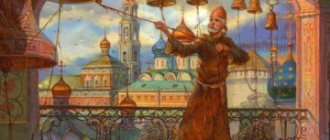The ringing of bells is considered miraculous because it has a largely unexplained by science effect on all living things, from microbes to humans. The sound made by a bell evokes sensations in a person that are unusual and incommensurable with anything we are used to. It is no coincidence that the bell is called a “ringing icon” and “a prayer in bronze.”
BELL HISTORY
In the IV millennium BC. e. In the territory of modern Southern Iran and Turkey, in Mesopotamia and Egypt, bronze casting technology already existed. But as soon as people learned to mine metal, they could not help but notice how long and powerfully it rings when struck (and the voice of bronze is especially beautiful).
A number of researchers believe that the birthplace of bells is China. Indeed, bronze casting technology was created in the Xia era (XXIII-XVIII centuries BC). However, among the objects found under the ashes of Herculaneum and Pompeii (1st century BC), there were bells 14 and 17 cm high. In the ancient world, they performed mainly signaling functions. In Ancient Rome, their ringing announced the opening of markets and baths, the watering of streets, executions and other events in city life.
The custom of calling monks to worship arose in Christian monasteries in Egypt. In Palestinian, Syrian, and Greek monasteries, special boards (beaters) are still used, which are struck with a mallet (rivet).
When bells were small, they were hung on the pediments of churches. As their weight increased, small towers began to be built for them on the roofs of temples. They called from the ground, pulling the rope. Since the 8th century, there have been reports of the first bell towers built separately from churches. Later, Romanesque and Gothic architecture combined the bell tower and the church into a single ensemble.
Improved casting technology made it possible to cast bells that were not only larger, but also those that produced the tone of the desired timbre. Already in the 9th century, sets of bells (up to 8 pieces) began to be made, creating a certain scale. In the early Middle Ages, they became widespread, and in the countries of Christian Europe from the 7th century they became an integral part of the everyday life of European cities and villages, since they symbolized goodness.
In the 12th century, a new casting technology was developed, which ensured high sound quality and the ability to increase the weight of the bell. Soon complexes appeared that united up to thirty bells. The system of keys, which the bell ringer hit with his fists, was supplemented with pedals. The bells followed each other according to semitones without spaces.
Thus, the period from the 12th to the 16th centuries occupies a special place in the history of bells: during these centuries their modern form and casting technology were formed.
LiveInternetLiveInternet
liveinternet.ru/users/paul_…347043369/
https://zvon.ru/zvon3.view5.page7.html ++++++++++++++++++++++++++
+++
| Maria Vasilievna Yakunchikova. 1870-1902 |
In Russian landscape painting of the 19th century, among many trends, there was one unique movement. Only a few artists belonged to it, who perceived nature not just as a beautiful landscape view, but as the embodiment of the highest harmony. They believed that communication with her elevates a person and can contribute to the transformation of his soul. At the end of the century, Isaac Ilyich Levitan and Maria Vasilievna Yakunchikova belonged to this direction. What is especially interesting for us is the fact that they paid great attention not only to the correct rendering of colors and light and shade, but also to the reproduction of harmonic rhythms by means of painting. The synthesis of Russian nature and Orthodox architecture was of great importance to both, and they considered the ringing of bells to be the best expression of the harmony of nature and art. Each artist had his own reasons for such a deep perception of nature. Maria Vasilyevna Yakunchikova was strongly influenced by her childhood impressions. She spent her childhood in Moscow. For the summer, the Yakunchikovs usually went to Vvedenskoye, their estate near Zvenigorod near Moscow. Not far from the estate there was the ancient Church of the Assumption on Gorodok and the Savvino-Storozhevsky Monastery. Maria Vasilievna’s elder sister, Natalia Vasilievna, later recalled: “When on Saturday evenings, during sunset, the measured, deep-sounding rumble of the bell from the Savvino-Storozhevsky Monastery was suddenly heard, we children, sitting on the terrace, fell silent, imbued with this harmony of sound with nature" [1] . The Yakunchikovs loved walks to the ancient monastery. The influence of these impressions was subsequently reflected in both the character and work of Yakunchikova.
| “Church of the old estate in Cheryomushki” (1897, Tretyakov Gallery) |
The young artist’s fascination with the beauty of Russian culture intensified even more after she met the Polenov family in 1886. In the winter of that year, Elena Dmitrievna Polenova organized a study of the history and archeology of Moscow monuments. According to researchers, “scientific acquaintance with history and ancient architecture instilled in Yakunchikova a reverent attitude towards the monuments of the past, as an expression of the life of this past” [1] . This attitude remained with the artist throughout her short life. She returned to this topic several times in her later works. One example of the landscape is “The Church of the Old Estate in Cheryomushki” (1897, Tretyakov Gallery). The foreground shows the church that was located on the Yakunchikov estate. In the vestibule, under the canopy, a small selection of four bells is lovingly painted. The artist even captured the string for the ringing, although in general the picture was solved in a rather general way.
| “From the bell tower of the Savvino-Storozhevsky Monastery” (1891, Tretyakov Gallery) |
Maria Vasilyevna’s love for the ancient Zvenigorod monastery continued into her adult years. Although, due to the difficult financial situation, the Yakunchiks had to sell Vvedenskoye, Maria Yakunchikova often came to these places for the summer and lived for a long time in the hotel of the Savvino-Storozhevsky Monastery. One of the most poetic works created here by the artist is “From the Bell Tower of the Savvino-Storozhevsky Monastery” (1891, Tretyakov Gallery), where in the foreground are depicted the very bells that once awakened in her soul the first feeling of beauty and harmony. Using this small painting as an example, the artist’s special attitude towards Russian nature is especially well felt. Just like Levitan, she seems deeply spiritual to her. The significance of a modest landscape is given by a special technique - a view as if from above. Thanks to this, ancient bells acquire a dominant position; they are depicted deliberately large in relation to the distance. What connects them into a single whole is an unusually pure, even sunny azure tone that permeates both nature and the bells. Yakunchikova was able to convey even the feeling of the bell that had just sounded. The special, vibrating character of the stroke seemed to capture the vibration of the largest bell [2].
| "Evening. Golden Reach" (1889, Tretyakov Gallery). Fragment |
Isaac Levitan conveyed his feeling of the bell ringing differently. On his canvases, sound waves are embodied in concentric and oval lines, with the help of which the composition itself is built. Often they echo the majestic flow of the river, creating the effect of interaction between eternity and the flow of time. One of Levitan’s most remarkable works “Evening. Golden Ples" (1889, Tretyakov Gallery) was inspired by the ringing of bells in a small bell tower in the city. Soft delicate colors and smooth outlines of the Volga flow amazingly authentically created a peaceful atmosphere of a summer evening in the Russian city. One of the artist’s contemporaries wrote about this painting: “It seems as if the bell is about to ring and the prayer words “Glory to God in the highest, and on earth peace, and good will to men” [3] . Levitan’s other painting “Quiet Abode” (1890, Tretyakov Gallery) is imbued with the same feeling of quiet reverence. It does not depict any specific monastery; rather, it is a generalized poetic image. In many ways, it was inspired by the poetic beauty of the Savvino-Storozhevsky Monastery, where the artist, like Maria Yakunchikova, loved to visit, and a small monastery in the vicinity of Yuryevets on the Volga. Here, the soft range of golden tones especially well conveys the slightly sad beauty of Russian nature, part of which can be called a monastery surrounded by a grove, with a white church and an elegant, slender bell tower. It seems that the turn of the river emphasizes the measured rhythm of the quiet monastery ringing, spreading throughout the area, like circles on water. The colors flashing on the water and in the foliage can be compared with its sonorous accents, and the measured flow of the river unites them into a single rhythm or a single flow.
| “Quiet Abode” (1890, Tretyakov Gallery) |
Levitan was not an Orthodox Christian, but he surprisingly deeply felt the beauty of Russian Orthodoxy. One of his letters to friends from Nice in April 1894 speaks very well about this: “You are probably already... sitting in your family... on the eve of a bright holiday - the harbinger of spring. Probably in an hour the good news will ring out - oh, how I love these minutes, minutes that speak of the life of truth... of the triumph of truth...” [4] . One of Levitan’s most “musical” works can be called the painting “Evening Bells” (1892, Tretyakov Gallery). There is a poetic legend that it, like the “Quiet Abode,” was conceived by the artist after visiting the Savvino-Storozhevsky Monastery. “He did not paint the picture here; this is where he took the mood, the title, the singing of the monastery bell and the gentle light of the summer sunset on the water” [5] .
| “Evening Bells” (1892, Tretyakov Gallery) |
This review of the film is far from accidental. The whole thing is built on the rhythmic circular movement of the river, going somewhere into infinity. The very color of this landscape seems to sound like the measured rhythm of a bell ringing. It is saturated with warm chords of golden tones, azure and greenish undertones, evoking memories of the range of ancient Russian icons. Immediately after the creation of this canvas, they began to talk about Levitan’s surprisingly sensitive perception of the beauty of Russian nature: “typically Russian, even hermitic tenderness before the beauty of the evening in a holy place, nestled far from the world among the forests.” Literature: [1] Polenova M.V. Maria Vasilievna Yakunchikova. M., 1905. P. 1, 5 [2] Kiselev M.F. Maria Vasilievna Yakunchikova. 1870-1902. M., 1979. P.32 [3] Vermel S.S. Isaac Ilyich Levitan, his life and works. M., 1902. P.23 [4] Petrov V.A. Isaac Ilyich Levitan. St. Petersburg, 1993. P.77 [5] Razgonov S. Evening ringing.
Behind the monastery wall // Monuments of the Fatherland: Moscow Region. 1994. No. 31. P.33 compiler of the material - Olga Azarova
++++++++++++++++ Paul_V_Lashkevich
,
BELLS IN Rus'
Bells came to Rus' from the West. The first mention of them is contained in the 3rd Novgorod Chronicle and dates back to 1066. The early history of bells in Rus' developed in the same way as in the West. At first they were cast by monks, but pretty soon the matter passed to artisans. The bells were blessed, but they were never baptized or given human names. Although nicknames were often given: a bell with a strong, harsh sound was often called the Swan, with a soft, pleasant sound - Red, with an uneven, rattling sound - Goat, Ram.
In Rus', they were credited with the ability to cast out evil spirits, dispel intrigues and evil spells, avert thunderstorms, and heal diseases. At the same time, they were often subjected to severe punishments. In 1771, the alarm bell of the Moscow Kremlin, by decree of Catherine II, was removed and deprived of its tongue for calling for rebellion. In 1591, by order of Boris Godunov, the same fate befell the Uglich bell, which notified the people of the death of Tsarevich Dmitry. On
In Rus', bells measured the passage of time, sounded the alarm, warned of the approach of the enemy, summoned warriors, greeted victors, and welcomed noble guests. The sound of the veche bell convened public meetings in Novgorod and Pskov.
Travelers who came to Russia were amazed not only by the abundance of bells, but also by their weight. By the middle of the 16th century, Russian bells surpassed Western ones in size. If European bells weighing 100-150 poods (one pood is equal to 16 kg) were considered rare, then in Russia they were widespread.
In the Moscow Kremlin, bells of this weight category sounded on weekdays. Instances weighing up to 600-700 poods were called polyeleos and announced good news on memorable days, up to 800-1,000 poods were called Sunday and rang on Sunday, from 1,000 poods and above - holiday ones, they announced great joyful events.
SCIENCE EVIDENCES
According to the famous physicist Fotiy Shatunov, bells emit a huge number of resonant sound waves and thereby cleanse space. Shatunov proved: fully active bell ringing kills bacteria within a radius of 70 km and harmonizes space. The unique spiral-shaped trajectory of sound resulting from striking a bell turns out to be detrimental to many pathogenic microbes.
Due to the specific distribution of sound wave power, the structures of microbial cells come into resonance and are destroyed. Even microorganisms such as the hepatitis virus and anthrax spores die.
Ancient craftsmen possessed the secrets of making and casting bells with various types of energy radiation. It is believed that they were able to cast bells with a ringing sound that had a selective effect on pathogenic flora, which was, of course, only just guessed at then.
In the Middle Ages, bells were cast with a targeted anti-epidemiological effect: they killed the causative agents of plague in one case, and the causative agents of smallpox in another. Alexander Herzen wrote about an old crackling bell, which was placed on a podium in one of the Swiss cities because with its ringing it saved the inhabitants of this city and its environs from death during a plague epidemic!
Russian researchers back in the 70s of the last century established that such ailments as causeless anxiety, fears, nervousness and insomnia are perfectly healed by ringing bells. The conclusions drawn were simply amazing. It turns out that an audio recording of raspberry ringing has a calming effect on even the most violent mental patients. And listening to music performed on bells cures the most severe types of depression and other mental illnesses. Perfectly cures insomnia and raspberry church bells.
It turns out that the ringing of a bell contributes to a faster splitting of negative energies and a more complete removal of them from the human biofield. In addition, it generates exclusively positive energies of white and green colors in space.
Finally, bells are powerful harmonizers of space that help a person resonate with the harmony of the Universe and gain physical, energetic, mental and spiritual health.
Bell secrets
Probably, so many legends have been created about nothing in the world as about bells . They gathered people for prayer, were messengers of misfortune and joy, and announced the beginning of a new era. The ringing of a bell contains an unknown force that can change a person’s life.
Ringing for gods and spirits
The extraordinary properties of bells were noticed by people in ancient times. Initially, their shape was completely different from what it is now. They were made of copper or bronze plates, which were fastened together and resembled an oblong box with a beater inside.
In ancient China, tiny bells first appeared, which were used in magical rituals. It was believed that their gentle voices pleased the kind inhabitants of the subtle world, and therefore, having enjoyed them, the spirits would certainly fulfill the person’s request. In addition, the first bells also served as amulets, because, according to legend, dark entities could not stand their ringing.
In Ancient Egypt, bells played an important role during holidays dedicated to Osiris, the master of the world of the dead.
The Greeks considered the ringing of bells an appropriate gift to the gods. Thus, the oak grove that surrounded the oracle of Dodona in Epirus was all hung with them, so that the ringing of bells would delight the ears of the gods and they would not skimp on gifts to people.
In Rome, bronze bells decorated the chariots of triumphants and were also used in sacrifices to the gods.
Flower tip
Only in the 5th century did bells of a shape already familiar to us first appear on the belfries of churches.
And the following legend tells how this happened for the first time.
Once in a dream, the bishop of the city of Nola (Italy), Saint Paulinius, saw an angel of God holding in his hands a bouquet of flowers that made a wondrous ringing sound.
Having looked closely at the flowers, the saint was surprised to recognize them as ordinary field bells. Fascinated by the wonderful sound, which Peacock could not forget even when he woke up, the bishop immediately ordered a huge flower to be cast from copper and hung in the city church, so that its ringing would call believers to prayer.
Fortune teller and helper in love
Soon the bells began to ring in all Christian countries. Even the poorest parish tried to purchase bells of different sizes for a harmonious melodic ringing. And when making them, tin and silver were now added to copper, which made the voices of the bells more sonorous.
People have always treated bells with trepidation, because it is not for nothing that many legends have been preserved telling about their unusual power. Thus, in Krakow there is a legend about the Sigismund (Sigmund) bell, which still hangs on the main belfry of the city and is one of the national symbols of Poland.
This copper beauty, cast from captured cannons at the beginning of the 16th century, is considered a faithful assistant to girls in love affairs and over its long history has helped more than one young charmer find female happiness.
To enlist his help, you just need to climb the belfry and sincerely tell the ancient giant (the weight of the bell reaches 12,600 kilograms) about your heartfelt feelings, and then hug the bell’s tongue.
In addition, it is known that bells can warn of danger. Thus, the residents of York (England) and Erfurt (Germany) have been listening carefully to the ringing of “Great Peter” and “Maria Gloriosa” for several centuries, since when their voices become dull and menacing, this means the approach of an epidemic, war or death of the ruler.
"Tsarsky" gospel
On Russian soil, bell ringing first sounded only at the beginning of the 11th century, but almost immediately won the love of the people.
For a long time, people believed that bells were alive, since they had the power to disperse devilish forces, bestow health and... expose the villain.
It was believed that even a very expensive bell, donated to the temple by a person with an unkind heart, has a dull and rough voice, and sometimes “goes numb” - and not a single bell ringer, even the most skilled, would extract a single sound from it.
It must be said that the bells were responsible for their “misconducts” according to the law, like living people. The handsome men were executed - their tongues were torn out, they were whipped, and they were exiled to Siberia. An example of this is the bell of Uglich.
This alarm bell was executed by cutting off an ear and exiled to the Siberian Tobolsk for notifying the residents of Uglich about the death of Tsarevich Dmitry in 1591, which caused popular unrest. The bell was in exile for almost 300 years, after which it returned to its hometown.
But still, this is rather an exception to the rule, since bell ringing was very popular in Rus'. Ivan the Terrible, together with his sons Ivan and Fyodor, went up to the belfry every day at four o’clock in the morning to announce the gospel for Matins, and put his associates, who shirked the honorable right to accompany the ruler and princes to the bell tower, under arrest for eight days.
Tsar Fyodor Alekseevich could listen to bells for hours and was able to replace any most skilled bell-ringer. He often said that if he had not been born a royal son, he would have gone to serve as a sexton.
The famous commander Alexander Suvorov also admired the bells. During his exile in the village of Konchanskoye, Alexander Vasilyevich regularly climbed the bell tower to notify the peasants about the beginning of church services.
It was in Russia that a special type of blagovest was born, which begins with three single strikes of a large bell. It is believed that upon hearing the first blow of the belfry, the evil spirit freezes, the second time it tries to run away, and with the third it falls into hell.
By the 18th century, our ancestors began to use bell ringing in everyday life as a talisman. It was then that small bells began to be hung on the necks of livestock in order to protect them from the machinations of the evil spirit. On the way, the coachmen were protected from all misfortunes by loud bells under the arc. Even 100 years ago, the wedding train was completely decorated with small bells, because their ringing protected the newlyweds from damage and the evil eye.
Giver of Healing
Back in the Middle Ages, the healing power of bell ringing was noted. During plague epidemics, all the belfries of European cities “came to life,” as people believed that the voices of the bells expelled disease and purified contaminated air.
In Rus', the water that the bell washed the tongue was considered the best cure for deafness and dumbness. For a long time, the voices of bells treated the possessed. The patient was specially taken to the belfry, where a large bell was placed under the tongue. After this, the bell ringer began to ring small bells, which helped achieve the desired effect.
Even 100 years ago, plaque removed from bells was used as a cure for all skin diseases, since an ointment made from it could cope even with such a serious illness as ringworm.
At the time of the Easter bell, girls hurried to wash themselves with spring water in order to preserve youth, health and beauty longer.
It must be said that these days the secrets of the healing power of bell ringing have been revealed. Esotericists believe that when a bell is struck, its internal space is filled with positive energy, which has a beneficial effect on a person. In addition, the sounds of cast beauties restore a person’s biofield and increase his energy potential.
Also, the living voices of belfries “sterilize” the space, and therefore it would be nice in those houses where people often quarrel, to turn on audio recordings of bells ringing or hang so-called wind music, which is recommended by the Taoist practice of symbolic organization of space, Feng Shui.
Today, even some doctors recommend that their patients suffering from nervous disorders and cardiovascular diseases regularly listen to the ringing of bells. It helps as an additional remedy in the treatment of neuroses and to get rid of insomnia.
Elena LYAKINA, “Secrets of the 20th Century” magazine
FOLK BELIEFS
Bells were often rung during thunderstorms to ward off thunder and lightning and protect everyone who heard the ringing from material and spiritual danger. “Wherever the sound of this bell is heard,” says one eighth-century benediction, “let hostile forces be removed, also the shadow of ghosts, the rush of a whirlwind, the strike of lightning, the fall of thunder, the destruction of a storm, and all spirits of hurricanes.”
The ringing of bells is indicative from the point of view of distinguishing between “pure” and “impure” time. In all Slavic traditions, there are known beliefs that some mythological characters appear before people's eyes and engage in their malicious activities only after the bell rings. This especially applies to the period from Holy Thursday to Holy Saturday, when the bells, in accordance with the church canon, do not ring at all.
The silence of the bells is the time of their grief over the death and torment of Jesus Christ. To prevent evil spirits from having the opportunity to celebrate victory and do evil, during this period it was customary to replace the ringing of bells with other sounds: boys walked around the village at night with bells and rattles, old women beat branches on the church floor or benches in the church.
In the East, it is believed that the sound made by a bell corresponds to the sounds of mantras. Thus, the sounding bells resonate with the human energy system. At the same time, the work of the chakras is activated, and the energy currents intensify. The overall energy potential of a person increases. There is a harmonization of all human organs and systems - both at the level of the physical body and on the subtle planes.











